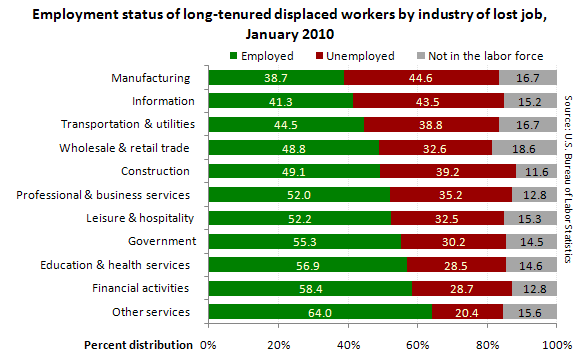September 02, 2010 (The Editor’s Desk is updated each business day.)
Reemployment rates of displaced workers, January 2010
From January 2007 through December 2009, 6.9 million workers were displaced from jobs they had held for at least 3 years. In January 2010, 49 percent of the 6.9 million long-tenured displaced workers were reemployed. This is the lowest reemployment rate on record for the series, which began in 1984.

[Chart data]
The reemployment rates for workers displaced from construction (49 percent) and wholesale and retail trade (49 percent) were the same as the overall reemployment rate for displaced workers. (Workers were not necessarily reemployed in the same industries from which they were displaced.)
By comparison, reemployment rates for workers displaced from jobs in financial activities (58 percent), education and health services (57 percent), and government (55 percent) were above the overall reemployment rate.
Displaced manufacturing workers were the least likely to be reemployed (39 percent) at the time of the survey.
These data are from the Current Population Survey program. To learn more, see "Worker Displacement: 2007-2009" (HTML) (PDF), news release USDL-10-1174. Displaced workers are defined as persons 20 years of age and older who lost or left jobs because their plant or company closed or moved, there was insufficient work for them to do, or their position or shift was abolished. The period covered in this study was 2007-09, the 3 calendar years prior to the January 2010 survey date.
Employment |
Industry studies |
Labor force |
Manufacturing |
Unemployment
Of interest
Spotlight on Statistics: National Hispanic Heritage Month
In this Spotlight, we take a look at the Hispanic labor force—including labor force participation, employment and unemployment, educational attainment, geographic location, country of birth, earnings, consumer expenditures, time use, workplace injuries, and employment projections.
.
Read more »
